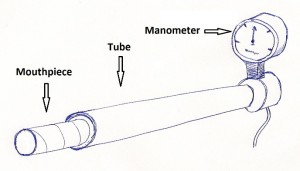This was named after Antonio Maria Valsalva from the 17th Century. This is a manoeuvre which increases the intra-abdominal pressure by straining against a closed glottis. It is a powerful stimulus of retrograde flow within the intra-abdominal and pelvic veins. This is in direct contrast to the other challenge tests which augment antegrade flow and rely on a relaxation phase to induce reflux. Coughing is a form of a Valsalva manoeuvre and in many patients with sapheno-femoral junction incompetence a thrill of reflux can be felt in this region during a cough. A Valsalva manoeuvre is often helpful in the identification of reflux from pelvic origin. A disadvantage of this test is that patients may not comprehend the request. Blowing into an occluded straw is often helpful as an instruction to patients.
CHRISTINA JEANNERET The Valsalva manoeuvre can be standardised by using a rigid tube with an airway pressure manometer at one end and a disposable mouthpiece at the other end. The subject is requested to look at the manometer dial whilst performing a forceful expiration into the mouthpiece. This visualisation provides subject feedback on the effectiveness of the Valsalva. Subjects are requested to blow as hard and fast as they can to achieve a pressure of 30 mmHg within 0.3 of a second and maintain this for a period of at least 3 seconds. Practice attempts may be required before subjects are comfortable with the technique.
The device has an inbuilt transducer which converts the expiratory signals into voltage and calibrates them into pressure so that the expiratory pressure can be displayed directly on the monitor of the duplex machine. This has the advantage that standard haemodynamic parameters can be measured and recorded, simultaneously. These include reflux measurements and venous diameter (d) changes. Recordings in real time using a cine-loop playback facility allow the reflux parameters and the relative diameter changes to be calculated.
The software of the duplex machine can measure the retrograde peak reflux velocity (PRV cm/s), the reflux time (RT s) and the time averaged mean velocity (TAMV cm/s). The flow volume (FVOL ml/s) and the absolute displaced volume (ADVOL ml) are calculated using the following formulas: FVOL = area (Π x d2/4) x TAMV and ADVOL = FVOL x RT.
